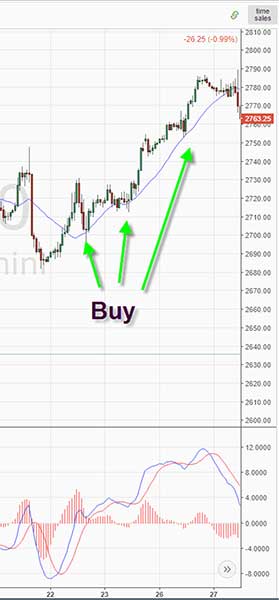How to interpret MACD crossovers and reversals.

Strategy macd is a trading strategy that uses the MACD indicator to generate buy and sell signals. The strategy is simple and can be easily incorporated into any short-term trading plan.
MACD can be used in conjunction with other indicators, like RSI or the moving averages. The MACD is one of the most popular and reliable indicators in technical analysis. It provides clear transaction signals that help minimize subjectivity in trading.
Moreover, MACD has been shown to provide additional insight into trends and momentum. It can also help you to identify possible reversal points.
If you are new to using MACD in your trading strategies, it is important to understand how to interpret the different signals that the indicator produces. Some of these signals are obvious and some may require more interpretation.
When the MACD line crosses above or below the signal line, it provides a buy or sell signal. This type of crossover can be very powerful in identifying key price levels when momentum is building.
A bullish MACD strategy divergence setup will form when two rising lows are accompanied by a trend reversal. This is a good time to take advantage of the bullish MACD trend by buying shares when the MACD reaches its peak and then selling them at a lower price.
Conversely, a bearish MACD strategy divergence setup will occur when two rising highs are accompanied by a trend deterioration. This is a good time to take profits on your positions when the MACD reaches its lowest point and then buy back in again when the MACD resumes its upwards trend.
The MACD and RSI are often paired together for a common trading strategy called the 50 MACD+CCI. This strategy can be used in Forex or any other market and has a few simple rules to follow.
The combination of the MACD and RSI can provide useful insights into trends, but a divergence between the two indicators can result in unwanted volatility and reversals. This can cause losses for traders who have not adapted their strategies to account for this change in direction.
You can mitigate the impact of this reversal by waiting for a second MACD overbought or oversold signal to occur – forming a double top or bottom – or by using a longer term trend. Alternatively, you can trade the divergence by simply avoiding long or short positions when it is occurring.
The MACD is a moving average, so it is normal to see reversals when the indicator moves in a different direction from the price. If you are trading with this indicator, it is important to use a stop-loss to avoid losing money when the price moves against your position.
When the MACD line is above the Signal line, it can indicate that a bullish trend has formed. However, it can also indicate that a bearish trend has formed.
In general, a positive MACD value is a sign that the short-term average has surpassed the longer-term average. The longer the MACD line is above the Signal line, the more likely it is that a reversal will occur.
In this episode, I sat down with Beejan Giga, Director | Partner and Caleb Emerson, Senior Results Manager at Carpedia International. We discussed the insights behind their recent Industry Today article, “Thinking Three Moves Ahead” and together we explored how manufacturers can plan more strategically, align with their suppliers, and build the operational discipline needed to support intentional, sustainable growth. It was a conversation packed with practical perspectives on navigating a fast-changing industry landscape.